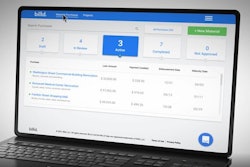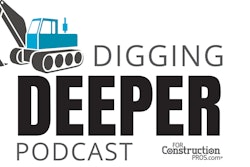
Editor’s Note: The following article is brought to you by Billd in partnership with the ForConstructionPros.com.
For some, the concept of debt can carry negative connotations and unnecessary risk — but in the construction industry, the benefits of debt often far outweigh the risks. For many companies, debt is a key factor in taking on more and larger projects, and ultimately growing their business.
Contractor financing, in particular, provides construction companies with the ability to purchase materials or labor upfront, and pay for them later after they’ve been paid. These delayed costs can open a world of opportunities for companies, allowing them to exponentially grow their businesses. Here’s how.
Improved cash flow
Cash flow challenges and slow payments are expected in the construction industry. There are multiple parties involved in any given project, so if any company in the chain experiences a payment delay, the consequences flow downstream. And that can have far-reaching effects on a construction company trying to grow its business.
Often, construction companies don’t get paid for 60 to 90 days after beginning a project but are required to front materials and labor. In fact, the average time it takes a contractor to get paid from when they start work is 83 days, according to Levelset. This can severely limit a contractor’s ability to take on additional projects.
Read next: Report: Cash Flow Problems Affect Nearly 20% of Construction Contractors
Financing, however, can help remedy that issue.
Let’s keep this simple, shall we? Let’s assume you are awarded a new project and you want to understand how much cash you need to get started. Let’s make the following assumptions:
- Project Contract Value: $1,000,000
- Project length - 4 months
- Materials - 40% ($400,000)
- Labor - 35% ($350,000)
- Overhead - 10% ($100,000)
Example without financing:
Your company will need to begin paying material, labor and overhead costs immediately, or within 30 days of starting work. However, you likely won’t begin to get paid for the project for about 60-90 days from when you start the work, based on industry averages. That means you’ll need enough cash to cover your expenses for the first two months of the project. During the third month, you’ll receive the first portion of your payment ($250,000) for the work you did in month one, but it won’t be enough to push you towards positive cash flow.
- Total Costs in Month 1 - $100,000 in Material + $87,500 in Labor + $25,000 in Overhead
- Total Costs in Month 2 - $100,000 in Material + $87,500 in Labor + $25,000 in Overhead
- Cash from Sales in Months 1 and 2 - $0
- Total Cash Spent = $425,000
- Total Costs in Month 3 - $100,000 in Material + $87,500 in Labor + $25,000 in Overhead
- Cash from Sales in Month 3 - $250,000
- Cash Balance After Month 3 - ($425,000) + $250,000 - $212,500 = ($387,500)
Ultimately, without any financing, you’ll need $425,000 in cash to take on the project, and you’ll have to survive negative cash flow for five months, even after the project has been completed. In this scenario, you end up with $150,000 in profit, but you’ll be putting your business at risk along the way.
Example with material and labor financing:
With material and labor financing, the scenario plays out much differently. While you will still have immediate overhead costs, you can delay your material and labor costs for up to 120 days, only paying small finance charges along the way, which usually amounts to about 2% per month.
For the first 2 months of the project, your expenses in this example include $12,500 of overhead per month and $4,950 of finance charges.
- Total Costs in Month 1 - $25,000 in Overhead + $4,000 Finance Charges
- Total Costs in Month 2 - $25,000 in Overhead + $8,000 Finance Charges
- Cash from Sales in Month 1 and 2: $0
- Total Cash Spent = $62,000
- Total Costs in Month 3 - $25,000 in Overhead + $12,000 Finance Charges
- Cash from Sales in Month 3 - $250,000
- Cash Balance After Month 3 - ($62,000) + $250,000 - $37,000 = $151,000
You only need $62,000 using financing, compared to $425,000 without financing to get started on this project. And, in month three, you’re already experiencing positive cash flow. As you can see, there is a cost to financing, and your profit at the end of this project sits at $102,000, versus $150,000 without financing.
Financing not only frees up cash but also enables you to take on larger projects, and more projects, all while stabilizing your business and minimizing risk.
Cash on cash return
While cash on cash return is typically used in real estate investments to understand how much cash was generated from the cash invested, it can be applied to this situation nicely. Essentially, it tells you the return you made on your investment relative to the risk (amount of cash you had to put up to finance the project).
If you consider your Cash on Cash Return with financing versus without:
- Using financing: $102,000 / $62,000 = 165%
- Without financing: $150,000 / $425,000 = 35%
The return you get on your actual cash is significantly amplified by using financing.
Increased ability to take on (and successfully complete) larger projects
One key way to grow your business is to take on larger projects. Larger projects come with bigger rewards, of course, but they also come with more risk — namely, your ability to successfully complete that project and turn a profit on it. If your company doesn’t have the bandwidth, employees or equipment to take the project from bid to completion, you can jeopardize both your reputation and your ability to win future projects.
Financing can help minimize that risk by enabling you to invest in the resources you need to complete those projects, including:
- Materials: Larger projects will almost always necessitate more materials. With material purchase financing, you get the materials now to start the project but delay paying for them until you get paid.
- New or more equipment: New equipment can be prohibitively expensive. However, by using financing, you may be able to invest in a piece of equipment that can help you complete a larger job at a faster rate — all without having to put up cash that otherwise would have gone towards payroll or monthly overhead.
- Additional labor: To meet the needs of the project, you may need additional labor with specialized skills or expertise. With financing, you can hire the people you need to successfully complete the project.
Through financing, you can take on projects with significantly less cash up front. That can be the key to taking on multiple projects at once. Rather than taking on one $1,000,000 project with $425,000 from our example above, you could take on seven of those projects for approximately the same upfront cash by using material and labor financing. And that may be all you need to put your company on the fast track to exponential growth.
Read next: Understand When and When Not to Take Construction Business Risks
Financing isn’t something to shy away from. If your company wants to grow, financing can provide a clear path forward. With less cash required upfront, your company can take on larger projects — and often, even multiple larger projects — with confidence.
Want to calculate your next project to see how much cash you need to get started, with and without financing? Check out this cash flow for contractors tool from Billd.



















